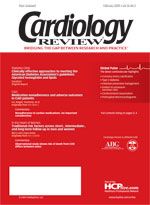Publication
Article
Cardiology Review® Online
Letters to the Editor: Dyspnea, pulmonary hypertension, and chronic obstructive pulmonary disease
After reading Dr Reddy’s re­view of pulmonary artery hypertension,1 I was wondering if he would address the question of how much of the symptoms of dyspnea are due to pulmonary hypertension in the patients with chronic ob­structive pulmonary disease (COPD) who have elevated pulmonary artery pressures? It is interesting to me that some, but certainly not all, of my patients with COPD have elevated pulmonary arterial pressures and preserved left ventricular function. Sometimes their FEV1 and FVC are only moderately reduced, so I’ve also referred them for poly­somnography to look for obstructive sleep apnea. In those situations, only about one third seem to have this condition. I have also ordered V/Q lung scans to rule out occult recurrent thromboembolism, and they’ve been negative. I haven’t seen any data on treating pulmonary hypertension in patients with only COPD.... Is there any justification for pursuing this?
Howard Homler, MD Sacramento, Calif.
Reference
1. Reddy G. Pulmonary arterial hypertension: a review. Cardiol Rev. 2005;22(8):24-27.
Response:
The pathophysiology linking COPD and pulmonary artery hypertension (PAH) is manifold. The progression of COPD to PAH can be caused by such mechanisms as hyperinflation and V/Q mismatch, and both can contribute to pulmonary artery remodeling. This is one of the key mechanisms contributing to PAH. Reduction of the pulmonary vascular bed, common in COPD, can also cause increased pressure in the pulmonary arterial system, and increased cardiac output and in­creased left atrial pressure can also lead to the worsened PAH.
As far as the epidemiology of PAH in COPD, one author estimates that 5% to 10% of patients with advanced COPD suffer from severe PAH. The prevalence of clinically significant severe pulmonary hypertension in COPD is roughly estimated to be of 1 to 2/1000.1 There is justification in treating PAH in patients with COPD. The possibility of improving quality of life with newer medical therapies is promising. One of these drugs is sil­denafil citrate (Revatio). In a study of 6 patients with severe COPD, mean pulmonary artery pressures were reduced and there was notable improvement in excercise tolerence.2 There­fore, if PAH can be determined in the presence of COPD and the patient has no contraindications, sil­denafil may be considered as therapy in addition to oxygen therapy.
Girish Reddy, MD Stony Brook, NY
References
1. Naeije R. Pulmonary hypertension and right heart failure in chronic obstructive pulmonary disease. Proc Am Thorac Soc. 2005;2(1):20-22.
2. Higenbottam T. Pulmonary hypertension and chronic obstructive pulmonary disease: a case for treatment. Proc Am Thorac Soc. 2005;2(1):12-19.
Commentators’ criticisms off target
I wanted to respond to the commentary by Drs Miyawaki and Maesaka in the November issue,1 which discussed our article in the same issue.2 In that article, we found that for uncomplicated hypertensive postmenopausal women, the combination 2 drug-class regimen of diuretic plus calcium channel blocker was associated with a higher risk of cardiovascular mortality than a diuretic plus an angiotensin-converting enzyme (ACE) inhibitor or diuretic plus beta blocker.
Drs Miyawaki and Maesaka are correct in pointing out that this is an observational study and that such studies are subject to confounding by indication, which we controlled for by propensity analyses, although of course we cannot rule out confounding by unknown factors. Some of the statements they make, however, need correction or clarification.
First, they note that we did not distinguish between dihydropyridines and non­dihydropyridines. In fact, in the parent article, we did look at both types of calcium channel blockers and found no differences in our results3; because of space constraints this was not reported in Cardiology Review.
Second, they make the statement that “it was simply assumed that pa­tients remained on the medication they were prescribed at baseline…and were not switched during the trial.” This was not a trial, and patients were not prescribed the medications they were on at baseline. In fact, the duration that they had been on the therapy they were on at baseline ranged from 6.6 to 8.2 years, as stated in the article. Since their blood pressure was under control on their baseline therapy, it seems reasonable to assume they were not switched to another 2-class regimen, although it is possible that if their blood pressure rose during the follow-up, they may have been put on a higher dose, or a third drug class might have been added. However, this happens in clinical trials as well, but in intention-to-treat analyses, patients are counted in the group to which they were randomized at baseline regardless of whether they needed to have another drug added.
Finally, the statement that “the end points in this study may not be reliable” is wrong. The Women’s Health Initiative (WHI) had the most rigorous ascertainment of end points, as described in nu­m­erous papers published on WHI.
The main point of our article is that there are not adequate clinical trials of 2 drug-class combinations, and that physicians selecting another drug to add to a diuretic should consider carefully their reasons for choosing a calcium channel blocker in favor of an ACE inhibitor or a different drug class. It would be desirable to mount a clinical trial in newly diagnosed hypertensives that starts out with a diuretic and randomizes patients to 1 of several other drug classes, but we do not have data from such a trial design.
We all do agree however that many patients are not treated aggressively enough to control their blood pressure.
Sylvia Wassertheil-Smoller, PhD Albert Einstein College of Medicine Bronx, NY






